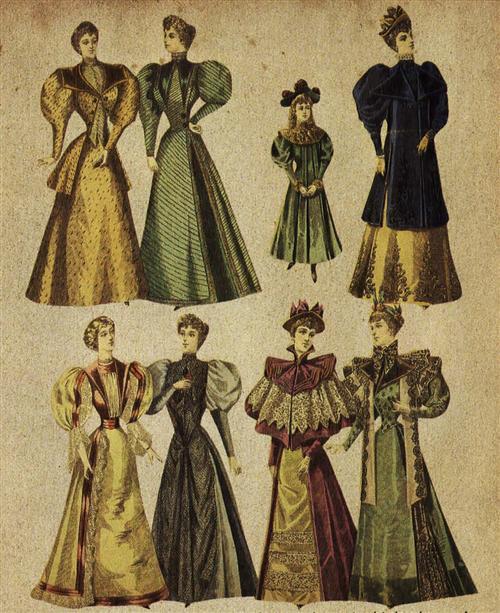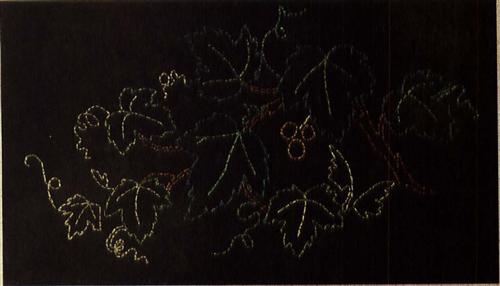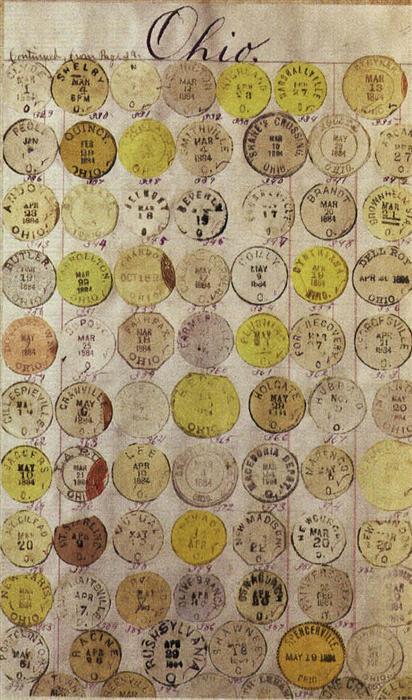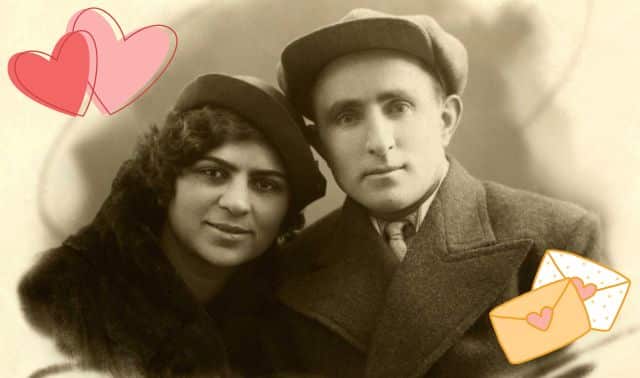Sign up for the Family Tree Newsletter Plus, you’ll receive our 10 Essential Genealogy Research Forms PDF as a special thank you!
Get Your Free Genealogy Forms
"*" indicates required fields

But the current fascination with scrapbooks isn’t entirely new. Nobody knows exactly how old this hobby is, but scholars trace its origins to the 17th century, when notes and prints were kept in albums. In the 19th century, “scrap” referred to colorful bits of paper that included product labels and greeting cards and even some papers created just for the scrapbook craze of the Victorian era. No one was immune to the lure of the scrapbook: Men, women and children compiled scrapbooks using purchased blank books or their own handmade books. These 19th-century scrapbookers collected mementos of friendships and paper memorabilia from their daily lives. They kept track of occurrences, quotes, recipes, knitting swatches and anything else they were interested in.
This earlier scrapbooking boom means you may have — or might discover — memory albums created by your ancestors. At first glance, these antique scrapbooks might seem confusing because of their sometimes odd combinations of materials. You may have questions about how best to preserve them for future generations. And you may be wondering exactly who created this old scrapbook — if you’re lucky, the person wrote his or her name in it — and what significance these items have for your family history.
Think of these ancestral scrap-books as a puzzle waiting to be put together. Each page contains pieces of the daily life and interests of a family member you don’t know much about yet beyond a name, date and a few details, The type of scrapbook and what it contains can tell a story about your ancestors and their lives if you know what to look for.
Evolution of the scrapbook
To place your old scrapbooks in time, it helps to know a bit about the history of this medium. Here’s a quick look at how scrapbooks evolved:
Common-place books: As early as the 18th century, educated men and women pasted quotes and phrases in things they called common-place books. Thomas Jefferson gathered newspaper articles of his presidency in leather-bound volumes, also including clippings, drawings and diary entries. By the first half of the 19th century, these common-place books featured embossed covers, engraved clasps and locks. They became a cross between a scrapbook and a journal. Hattie Harlow of Boston, a seamstress, organized her notes, clippings and illustrations by topic in separate handmade volumes with wallpaper and cardboard covers. One of her surviving common-place books even includes knitting samples with directions.
Granger books: Building on the popularity of common-place books, in 1769 William Granger introduced a printed book with extra blank pages so that the owner could personalize it with autographs, letters or illustrations relating to the subject of the publication. A Granger book on the history of London, for example, might be embellished with clippings of illustrations, travel notes and even plant samples. Early scrapbookers began imitating the style by adding pages to existing publications. There were even manuals that described how to “extra illustrate” a book. Such books are difficult to locate in library collections because they’re usually filed under the author of the book, not under the name of the person who embellished the volume.
Friendship albums: These are a descendant of the autograph album, which originated in Germany in the 17th century. Young women often kept albums commemorating their family and friends in scrapbooks that resembled autograph books. Laura L. Sherwin of Fairhaven, Vt., actually donated a piece of hair for Hellen Marion Adams’ friendship album. Collecting hair weavings and swapping friendship tokens was a standard part of Victorian female friendships. (For more on hair and friendship albums, see the August 2002 Family Tree Magazine or go online to <www.familytreemagazine.com/articles/aug02/attic.html>.) Young women in the Victorian period often created memory books or visitor albums filled with signatures, scrap, cards, hair, handwriting, poetry and photographs of their family and friends. These could be shared and added to whenever someone came to visit.
Scrapbooks: A scrapbook is a collection of any type of material pasted into an album, but it usually consists of paper materials, photographs and memorabilia. The peak years for scrapbooks in the 19th century were from 1880, when a popular manual on the topic was published, to about 1890. These books’ colorful scraps, known as “ephemera,” were meant to be disposable, not collectible. While 19th-century albums hold an assortment of material accumulated as the compiler went through her daily routine, some “scrap” was purchased expressly for the albums. Scrap manufacturers created a demand for their product by offering sheets in new styles directed at women and children, much like the advertisers in today’s scrapbook periodicals. Women’s magazines featured numerous articles on the value of scrapbooks as a family activity and educational tool, encouraging novices to join the craze.
Just as today’s scrapbooks often have a theme, earlier generations of scrapbook enthusiasts also created albums for a variety of purposes. Housewives kept the labels and trade cards from new consumer products and included them in their albums, while male and female college students documented their years at school. In fact, if you can’t find a scrapbook created by an ancestor and you know the person attended a particular college, contact the special collections department at that institution to see if it has one compiled by a classmate. It might feature your ancestor’s photograph or autograph. At the very least, you’ll discover details about your ancestor’s college experience.
Perhaps even more so than today, scrapbooking was a hobby for anyone. Ordinary citizens and even President Rutherford B. Hayes spent time adding to their scrapbooks. Mark Twain was such an avid scrapbooker that he reserved Sundays for his hobby. He held patents for his invention of self-fastening scrapbooks that could be dampened with water. By 1901, at least 57 different types of Mark Twain albums were available. Popular catalogs such as those for Montgomery Ward offered albums for sale, though many individuals also created their own albums.
More recently, the World War II paper shortage led to a scrapbooksharing program. Books Across the Seas sponsored an exchange between students in England and the United States. These albums, worked on as group projects, focused on local history and student life.
Over the years, scrapbooks have included paper items of the period ranging from advertisements to greeting cards, arranged by subject or type of material. Some hobbyists used their albums as a form of artistic expression. One scrapbooker dressed the paper cutout figures on her pages in actual fabric swatches. The wonderful thing about looking at an ancestral scrapbook is that it offers you a glimpse into the world in which your family lived. You can find the small details that enliven a genealogy.
Today, of course, it’s a rare scrap-book that doesn’t include photographs. Although scrapbookers began using images in their albums in the mid-19th century, it wasn’t until the Kodak camera became available in the 1880s that photographs started to appear in most albums along with scrap. Photo albums per se aren’t considered a type of scrapbook because they contain only images.
Photo albums grew in popularity with the spread of inexpensive cameras and film, and for a time supplanted scrapbooks. As interest in scrapbooks waned in the mid-20th century, their format remained unchanged for several decades.
When family history saw a resurgence of interest in the late 1970s in the wake of Alex Haley’s Roots, scrap-books once again became a popular hobby using “magnetic” albums with self-adhesive pages and plastic cover sheets. (From a photo-preservation standpoint, however, this was a disaster, as these new albums can damage the very pictures they’re meant to preserve.) At an international genealogy conference in Salt Lake City in 1980, several people exhibited their family scrapbooks. This created a demand for new products, magazines and preservation information, and helped spark today’s billion-dollar industry.
Finding ancestral scrapbooks
Old albums are not difficult to locate and may fall into any of the categories listed here — common-place books, friendship albums, extra-illustrated books or scrapbooks. Most archives and libraries have albums and scrap-books in their family manuscript collections — maybe even something created by your ancestors.
To locate ancestral scrapbooks, you can use the same basic techniques employed to find any other type of old family document:
• Contact all your relatives and see if they know of any scrapbooks created by your ancestors. You might just get lucky!
• Search for your family names in the National Union Catalog of Manuscript Collections (NUCMC). It’s available at many libraries, and you can access some years online at <www.loc.gov/coll/nucmc/nucmc.html>.
• Search online auction sites such as eBay <www.ebay.com> for family memorabilia, including scrapbooks.
• See if the local historical society or state historical society in your family’s old stomping grounds has material on your ancestors, including scrap books. Contact the society directly. Not all manuscript collections are listed in NUCMC.
Perusing the pages
While the types of albums our forebears kept don’t necessarily resemble the ones hobbyists create today, they tell a story just like a photo album does — but you have to know what to look for. Your first step is to examine the inside front cover to see if there’s a signature that identifies the maker. Next, look for a title page. Some individuals chose a theme for their book and titled it and/or wrote a short introduction. Carefully turn the pages and look at what’s on each one. Go through the album completely to get a sense of what the creator collected for its pages and whether the type of material changed as time passed. Try to answer these questions:
• Was the album created by one person or added to later by another individual? Just because it’s a single scrapbook doesn’t mean that the original creator didn’t let someone else add to it later on. For instance, a mother might have started the book when she was a young woman and then taken it out of storage to let her children make additions.
• Who created it? If you don’t know the creator’s name, can you tell if it was a male or female adult or child? You’ll be surprised by the similarities between what children collect today and what they did a hundred years ago. Boys in the 19th century didn’t accumulate pictures of girls’ toys any more than they would today.
• What type of scrap is on the page? You can date a scrapbook by using city directories to find dates when a business was in operation or by researching the product labels. If it’s a friendship album, you’ll be able to research each of the people who left tokens in the book, and perhaps discover new family relationships.
• Is there a theme? Is the album a collection of family material, random scraps artistically arranged or a creation for a particular purpose? For instance, one woman created a wedding scrapbook with memorabilia from her bridal showers, including a list and description of gifts, many of which are still in the family today. Other young people used scrap to create fanciful designs that illustrate their artistic talent, but are strictly ornamental.
Caring for old scrapbooks
If an actual ancestral scrapbook comes into your possession, you’ll want to preserve it for future generations to enjoy. The steps to preserving old scrapbooks depend on the materials used to create them. Unless they were assembled before paper was made from wood pulp (circa 1865), the pages are going to be extremely brittle and yellowed because of the acid and lignin contained in the paper. Lignin is the same substance that turns newspaper yellow. Adhesives used to paste items on the page can also deteriorate, so pieces start falling out of the album. The most expensive solution is to consult a paper conservator. A free list of conservators in your area is available from the American Institute for Conservation of Historic and Artistic Works <aic.stanford.edu>. A conservator can stabilize the damage and stop the deterioration. A less-expensive solution is to purchase acid-and lignin-free papers from suppliers (see the box on the previous page) that can help you preserve the scrapbooks by storing them in boxes with reinforced corners and interleaving the pages with acid-and lignin-free papers.
Here are a few tips to save your ancestral scrapbooks:
• Handle carefully. The fragility of the paper and the scraps means that you can unintentionally break off pieces of the album pages. Loose fragments can also float out of the album, so be sure to brace the spine of the book when you open it, and turn the pages slowly.
• Store in a stable environment. Changes in temperature and humidity can affect the life of an album. The rate of deterioration directly relates to heat and moisture. Store your scrap-books like photographs, in a windowless closet in special storage containers.
• Pick safe materials. Use materials that will help prolong the life of your scrapbook, especially materials tested for use with scrapbooks. Wrap albums in acid-and lignin-free paper so that loose pieces aren’t lost, then place in acid-and lignin-free boxes with reinforced corners.
Even if you haven’t joined today’s scrapbooking boom, you’ll appreciate the beauty and historic value of an ancestral scrapbook. It took a great deal of time and dedication for your ancestors to gather materials and to plan a page.
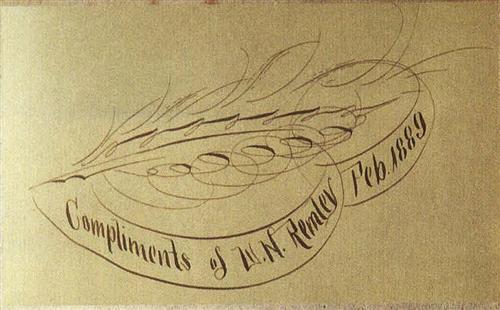
Scrapbooks filled with autographs were popular in the 19th century. In this type of book, you might discover the signature of someone famous.
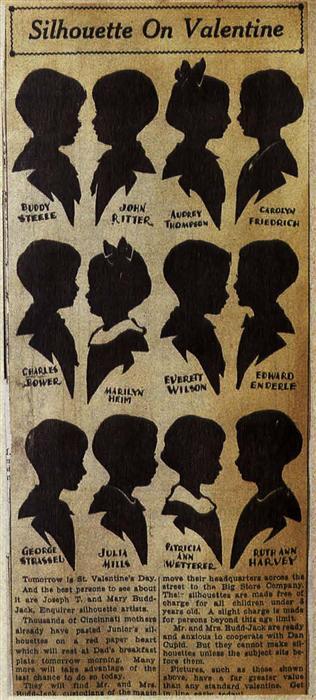
Some scrapbooks, such as this one of silhouettes, illustrate their keepers’ creativity.
This particular scrapbook contains postage labels from every state. The page above features those for Ohio
ADVERTISEMENT

